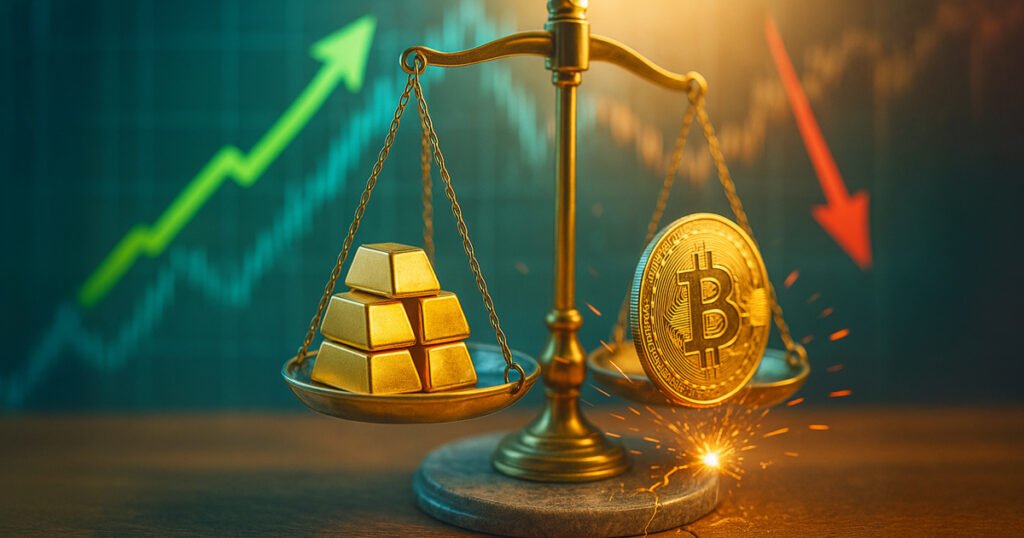Gold Beats Bitcoin: The Rise of Precious Metals in Turbulent Times
In recent years, Bitcoin has often been referred to as "digital gold," a modern-day asset seen as a hedge against inflation and economic instability. However, with escalating geopolitical tensions and renewed trade disputes, traditional gold is reclaiming its position as the primary store of value. As of October 17, gold reached an all-time high of $4,376 per ounce, propelling its market capitalization to an impressive $30 trillion. In contrast, Bitcoin’s valuation stands at approximately $2.1 trillion—making gold nearly 14 times larger and surpassing the combined worth of tech giants like Apple, Microsoft, and Nvidia.
The Impressive Surge of Gold
Year-to-date, gold has witnessed a staggering 60% gain, significantly outperforming both the S&P 500’s 14% and Bitcoin’s 17% surges. This recent price movement can be traced back to rising tensions following U.S. President Donald Trump’s announcement of new tariffs on China. Such political actions have historically jolted global markets, leading investors to seek safety in traditional hedges. With central banks accumulating gold for several months, the asset emerged as the go-to choice for risk-averse investors looking to shield their portfolios from currency fluctuations and policy uncertainties.
In the words of Jurrien Timmer, Fidelity’s director of global macro, "Gold is in demand as countries strive to diversify themselves from the U.S. reserve currency hegemony." This sentiment is echoed by evidence indicating a steady increase in the share of reserves held in gold, now matching those held in euros. The growing preference for "hard money" over fiat currencies signals a looming shift in global economic dynamics.
A Shift Toward Tokenized Gold
The evolving market landscape is not just limited to physical gold; it’s also extending to digital greenbacks like tokenized gold on blockchain networks. Data from Token Terminal shows that tokenized gold products on Ethereum have surged over 100% year-to-date, now surpassing $2.4 billion in market valuation. Tether Gold (XAUT), a notable example, has seen its market cap more than double this year, jumping from $650 million to a robust $1.6 billion. Such data underscores a growing institutional interest in gold, with analysts estimating that inflows into gold products have outstripped those into Bitcoin by over $15 trillion since January 2024.
Bitcoin’s Declining Trajectory
On the contrary, Bitcoin is currently facing a volatile landscape as the same factors boosting gold are simultaneously weighing it down. Recent data from CryptoSlate indicates that Bitcoin’s price fell over 4% within a single day, dropping momentarily to its lowest point since June at approximately $103,300. Although the price has somewhat rebounded to $106,051, this represents a 16% decline from its all-time high of $126,173.
This downturn appears to reflect short-term panic rather than any inherent weakness in the Bitcoin market. According to James Elkaleh, CMO of Bitget Wallet, this market pullback can be characterized as "early panic-induced selling" spurred by tariff-related shocks. Coinperps data further highlights a shift in market sentiment toward "Fear," echoing levels last observed in April when Bitcoin dipped below $80,000.
Bitcoin as a Potential Safe-Haven Asset
Despite current challenges, some analysts remain optimistic about Bitcoin’s long-term potential in the face of political turmoil. Elkaleh argues that Bitcoin’s fundamental characteristics position it well as a non-sovereign hedge against policy risk and currency debasement. He states, "Bitcoin remains a hybrid asset. In the early phase of macro shocks, it trades like risk-on tech equity, selling off alongside other high-beta assets." Yet, as liquidity conditions improve and confidence in traditional markets diminishes, Bitcoin tends to transition into a safe-haven asset.
This dual nature allows Bitcoin to benefit from its fixed supply and global accessibility, distancing itself from state-backed currency. As uncertainty looms, investors face a pivotal choice: whether to abandon the allure of Bitcoin for the time-tested reliability of gold or to hold on to the promises that digital currencies entail.
The Future Outlook for Gold and Bitcoin
As the chasm between gold and Bitcoin continues to widen, the economic landscape poses questions about the future viability of both assets. Achieving a balanced perspective will be essential for investors trying to navigate this turbulent market. While gold’s historical stability in times of crisis seems undeniable, Bitcoin offers a disruptive alternative that could redefine value storage in a digital age.
In the coming months, the ongoing volatility in both precious metals and cryptocurrency markets will likely shape investor sentiment further. As traditional hedges gain momentum, Bitcoin’s adaptability may ultimately steer it back into favor if the market perceives greater instability ahead. The next chapter for both assets will be crucial in determining the narratives surrounding currency, value, and safeguarding wealth amidst uncertainty.
Moving forward, investors will need to weigh the merits and risks associated with both gold and Bitcoin, understanding that the landscape is continually evolving. Whether one leans toward the traditional appeal of gold or the innovative promises of digital currencies, the underlying factors driving these assets will remain intertwined with broader economic and geopolitical developments in the years to come.


